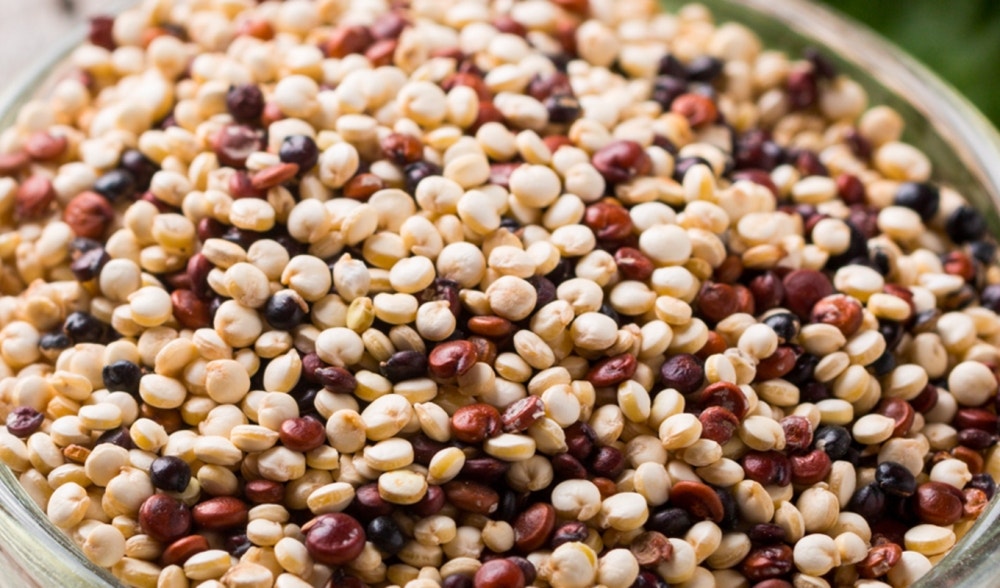Known and used since ancient times, quinoa is a food with remarkable characteristics and is now regularly present on our tables.
Generality
Quinoa (Chenopodium quinoa) is a herbaceous plant belonging to the Amaranthaceae, which typically grows in South American countries. Equipped with high resistance and adaptability, it is able to grow in variable conditions, from arid soils up to high altitudes. The characteristic seeds have a very small diameter, about 2-3mm, and depending on the variety of the plant they can appear with different chromatic shades: red, white, black. Botanically, it is considered a pseudo-cereal, which is a plant grown and treated according to methods typical of cereals.
The seeds, in particular, before being consumed, must undergo a washing, necessary to remove the thin external protective layer rich in saponins, molecules with a bitter taste that can generate gastrointestinal discomfort if taken in excess.

Nutritional profile
- 100 gr. of raw quinoa provide about 350-370kcal, in line with cereals. Also in this case, therefore, it is necessary to pay attention to the quantity of quinoa that is consumed, above all, when there is a need to monitor one's caloric intake.
- Proteins represent about 13-14% of 100 gr. of fresh product, a higher percentage than the most common cereals. The quantity is associated with the quality of the same, as the amino acid profile presents all the essential amino acids in balanced ratios.
- The carbohydrates constitute about 65% of the weight (always referring to 100 gr. Of raw food), mostly consisting of starch, with a fairly high percentage of Fibre (6-10 gr.), Soluble and insoluble.
- The lipids, more abundant (about 6 gr.) Than cereals, are mostly unsaturated fatty acids (linoleic acid, oleic acid and palmitic acid), with an omega6 / omega3 ratio of about 5: 1; acceptable, if we consider the western diet in which this ratio is around 20: 1.
- There is no shortage of vitamins, belonging to group B (thiamin, riboflavin, vitamin B6 and folate), vitamin C and vitamin E.
- The minerals (Calcium iron, phosphorus, magnesium, potassium, copper, zinc, selenium and manganese) are present in varying concentrations depending on the growth conditions, the characteristics of the soil or of the plant variety. On average, the mineral content is higher than all cereals, although bioavailability is also in this case influenced by the presence of “anti-nutrients” (phytic acid) which, by binding to them, hinder their absorption. However, by washing it is possible to remove these compounds, increasing the available fraction.

A food for everyone?
Given the biological value of Protein, it is useful for satisfying the protein requirement, especially in the case in which dietary regimes lacking in terms of quality and quantity of this macronutrient are adopted.
The natural absence of gluten constituent Protein (gliadins and glutenins) makes quinoa perfect for celiac subjects, who most often have to resort to gluten free foods industrially treated according to processes that affect its quality. In a society now devoted to the demonization of gluten and the continuous search for increasingly innovative products, simplicity pays off; nature offers us excellent alternatives that are much healthier.
The amount of fiber is useful on several fronts:
- promotes the sense of satiety;
- regulates intestinal transit;
- reduces markers implicated in metabolic health (glycemic fluctuations, cholesterol levels);
- prebiotic effect on intestinal flora.

As in most foods of plant origin, we find a wide variety of phytonutrients and bioactive compounds. In the case of quinoa these mainly belong to sterols (sitosterol, campesterol, stigmasterol), flavonoids (quercetin and kaempferol) and tannins, whose antioxidant, anti-inflammatory and metabolic support properties are widely investigated at a scientific level.
Quinoa in the kitchen
Quinoa is a truly versatile food that lends itself to an infinite number of recipes, thanks to the soft and delicate flavor that does not overpower that of the foods it is combined with. The short cooking times (10-15 minutes) allow preparations even at the last minute: salads, first courses, porridge, desserts as well as baked goods, are just some of the possible alternatives.

In short, with quinoa we can give free rein to our culinary imagination, without feeling too bound to taste!
Bibliography
Vega-Gálvez A, Miranda M, Vergara J, Uribe E, Puente L, Martínez EA. Nutrition facts and functional potential of quinoa (Chenopodium quinoa willd.), an ancient Andean grain: a review. J Sci Food Agric. 2010 Dec;90(15):2541-7. doi: 10.1002/jsfa.4158. PMID: 20814881.
Abugoch James LE. Quinoa (Chenopodium quinoa Willd.): composition, chemistry, nutritional, and functional properties. Adv Food Nutr Res. 2009;58:1-31. doi: 10.1016/S1043-4526(09)58001-1. PMID: 19878856.
Granado-Rodríguez S, Vilariño-Rodríguez S, Maestro-Gaitán I, Matías J, Rodríguez MJ, Calvo P, Cruz V, Bolaños L, Reguera M. Genotype-Dependent Variation of Nutritional Quality-Related Traits in Quinoa Seeds. Plants (Basel). 2021 Oct 7; 10 (10): 2128. doi: 10.3390 / plants10102128. PMID: 34685936; PMCID: PMC8537255.
Pereira E, Encina-Zelada C, Barros L, Gonzales-Barron U, Cadavez V, C F R Ferreira I. Chemical and nutritional characterization of Chenopodium quinoa Willd (quinoa) grains: A good alternative to nutritious food. Food Chem. 2019 May 15;280:110-114. doi: 10.1016/j.foodchem.2018.12.068. Epub 2018 Dec 19. PMID: 30642475.
Filho AM, Pirozi MR, Borges JT, Pinheiro Sant'Ana HM, Chaves JB, Coimbra JS. Quinoa: Nutritional, functional, and antinutritional aspects. Crit Rev Food Sci Nutr. 2017 May 24;57(8):1618-1630. doi: 10.1080/10408398.2014.1001811. PMID: 26114306.
Anand David AV, Arulmoli R, Parasuraman S. Overviews of Biological Importance of Quercetin: A Bioactive Flavonoid. Pharmacogn Rev. 2016;10(20):84-89. doi:10.4103/0973-7847.194044
Chen AY, Chen YC. A review of the dietary flavonoid, kaempferol on human health and cancer chemoprevention. Food Chem. 2013;138(4):2099-2107. doi:10.1016/j.foodchem.2012.11.139
Dabeek WM, Marra MV. Dietary Quercetin and Kaempferol: Bioavailability and Potential Cardiovascular-Related Bioactivity in Humans. Nutrients. 2019;11(10):2288. Published 2019 Sep 25. doi:10.3390/nu11102288


Comments
Write a comment about the article